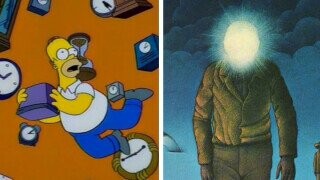Unpacking 'The Simpsons' Most Confusing Treehouse of Horror Joke

Welcome to ComedyNerd, Cracked's new deep dive series on all things GABBO! Today's topic: The Simpsons joke that left fans and crew confused for years.
It’s hard to pick a favorite Simpsons Halloween episode -- especially now that there are roughly 700 seasons to choose from -- but a strong case could be made for Treehouse of Horror V. The 1994 show features not only the “Nightmare Cafeteria” segment, which we’re going to choose to read as a scathing critique of America’s school lunch program, but also “The Shinning” -- the second-best parody of The Shining after Stephen King’s The Shining.
Don't Miss
The second story, “Time and Punishment,” is a riff on the classic Ray Bradbury tale “A Sound of Thunder” and finds Homer inadvertently inventing a time-traveling toaster. Even more confusing than the theoretical quantum physics that would explain how killing a prehistoric creature would lead to a future where it rains donuts is one random, throwaway joke early in the segment. As Homer is falling through some kind of clock-filled time vortex, he remarks that he’s the first “non-Brazilian person to travel backward through time.”
But … what does that mean?
The joke, seemingly some obscure reference, has baffled Simpsons fans for years. One possible explanation was included in the 1997 episode guide The Simpsons: A Complete Guide to Our Favorite Family. On the page for Treehouse of Horror V was a short blurb indicating that the indecipherable joke was really a reference to “hallucinogen-inspired author Carlos Castaneda.”

HarperCollins
Castaneda, a “godfather” of the new age movement, claimed to have been born in Brazil -- even though records indicate otherwise. He was the author of books like A Separate Reality, which purported to contain the teachings of “Yaqui Indian Sorcerer” Don Juan Matus, but that too was later debunked. Castaneda’s writings, while not explicitly about time travel, concerned lessons on shamanism and involved anecdotes about peyote trips, and also learning to use magic “without the use of drugs” which allowed him to, say, carry on conversations with a talking coyote -- which later inspired an entirely different Simpsons episode.
But despite its appearance in print, this explanation for the joke may not actually be the correct one. It turns out that this line wasn’t only confusing to viewers, it was confusing to Simpsons creator Matt Groening himself, who brought it up during the episode’s DVD commentary, asking the other writers: “‘non-Brazilian’ -- what does that mean?”
Originally, Homer was going to say “non-fictional,” not “non-Brazilian.” But according to producer David Cohen, the random specificity of “non-Brazilian” seemed funnier to everybody after pitching jokes for three hours. This was seemingly confirmed by Simpsons writer Josh Weinstein who Tweeted in response to a confused fan that it was just a “total non-sequitur” and “not a reference to anything, just a funny line.”
Of course, it was ultimately more maddeningly perplexing to the point of obsession than funny, but sure.
You (yes, you) should follow JM on Twitter!
Top Image: Fox/Simon & Schuster
